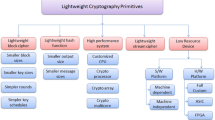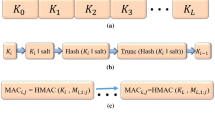Abstract
Broadband wireless communication users for 5G networks are primarily implemented in a complicated environment; the complex environment of time-varying multi-path propagation characteristics will seriously affect the performance of communication. One of the core technologies to overcome this problem is to introduce the environment adaptive technique—time reversal in the wireless link. Further, the problem of a Wiretap Channel in physical layer security research has become a popular research topic in recent years. To resolve the physical layer wiretap channel and multi-path fading problems in wireless channels, a novel concept of combining time reversal technology with physical layer security technology is proposed. In this paper, a physical layer secure transmission scheme based on the joint time reversal technique and artificial noise at the sending end is proposed for the wireless multi-path channel. First, in a typical wiretap channel model, the time reversal technique is used to improve the security of the information transmission process by using the properties of spatial and temporal focusing. Second, as the information is easily eavesdropped near the focus point, artificial noise is added to the sending end to disrupt the eavesdropping capability of the eavesdropper. Finally, due to the complexity of the multi-path channels, the influence of the antenna correlation on the system security performance is considered. Compared with the existing physical layer security schemes, theoretical analysis and simulation results show that the proposed scheme has a higher secrecy signal-to-noise ratio, a higher rate of secrecy, and a lower bit error rate of legitimate user.








Similar content being viewed by others
References
Yang, H., Bai, W., Yu, A., Zhang, J., & Wang, Z. (2017). Cross-stratum resources integration in fog-Computing-based radio over fiber networks for 5G services. In Opto-electronics and communications conference (OECC) and photonics global conference (PGC), Singapore, Singapore (pp. 1–2).
Ejaz, W., & Ibnkahla, M. (2018). Multi-band spectrum sensing and resource allocation for IoT in cognitive 5G networks. In IEEE Internet of Things Journal, 99, 1.
Liu, Y., Qin, Z., Elkashlan, M., Ding, Z., Nallanathan, A., & Hanzo, L. (2017). Nonorthogonal multiple access for 5G and Beyond. Proceedings of the IEEE, 105(12), 2347–2381.
Schinianakis, D. (2017). Alternative security options in the 5G and IoT era. IEEE Circuits and Systems Magazine, 17(4), 6–28.
Zhang, J., Podkurkov, I., Haardt, M., & Nadeev, A. (2017). Efficient multidimensional parameter estimation for joint wideband radar and communication systems based on OFDM. In IEEE International Conference on Acoustics, Speech and Signal Processing (ICASSP), New Orleans, LA, 2017 (pp. 3096–3100).
Proakis, J. G. (2001). Digital communications (4th ed.). New York: McGraw-Hill.
Stuber, G. L. (2001). Principles of mobile communications (2nd ed.). Dordrecht: Kluwer.
Goldsmith, J. (2005). Wireless communication. Cambridge: Cambridge University Press.
Tse, D., & Viswanath, P. (2005). Fundamental of wireless communication. Cambridge: Cambridge University Press.
Wyner, D. (1975). The wiretap channel. Bell System Technical Journal, 54, 1355–1387.
Chen, Y., Wang, B., Han, Y., Lai, H. Q., Safar, Z., & Liu, K. J. R. (2016). Why time reversal for future 5G wireless? [perspectives]. IEEE Signal Processing Magazine, 33(2), 17–26.
Han, Y., Chen, Y., Wang, B., & Liu, K. J. R. (2016). Time-reversal massive multi-path effect: A single-antenna, “Massive MIMO” solution. IEEE Transactions on Communications, 64(8), 3382–3394.
Bouzigues, M. A., Siaud, I., Ulmer-Moll, A. M., & Helard, M. (2014). Time reversal and equal gain transmission for 60 GHz millimeter waves orthogonal frequency-division multiplexing systems. In IEEE online conference on green communications (OnlineGreenComm), Tucson, AZ, 2014 (pp. 1–6).
Zhai, H., et al. (2010). An electronic circuit system for time-reversal of ultra-wideband short impulses based on frequency-domain approach. IEEE Transactions on Microwave Theory and Techniques, 58(1), 74–86.
Alves, H., Souza, R. D., Debbah, M., & Bennis, M. (2012). Performance of transmit antenna selection physical layer security schemes. IEEE Signal Processing Letters, 19(6), 372–375.
Yang, N., Suraweera, H. A., Collings, I. B., & Yuen, C. (2013). Physical layer security of TAS/MRC with antenna correlation. IEEE Transactions on Information Forensics and Security, 8(1), 254–259.
Tran, D. D., Ha, D. B., Tranha, V., et al. (2015). Secrecy analysis with MRC/SC-based eavesdropper over heterogeneous channels. Iete Journal of Research, 61(4), 363–371.
Al-Moliki, Y., Alresheedi, M., & Al-Harthi, Y. (2017). Physical-layer security against known/chosen plaintext attacks for OFDM-based VLC system. IEEE Communications Letters, 99, 1.
Sun, G., Han, Z., Jiao, J., & Wang, D. (2017). Physical layer security in MIMO wiretap channels with antenna correlation. China Communications, 14(8), 149–156.
Feng, Y., Yang, Z., Yan, S., Yang, N. & Lv, B. (2017). Physical layer security enhancement in multi-user multi-full-duplex-relay networks. In IEEE international conference on communications (ICC), Paris (pp. 1–7).
Singh, A., Bhatnagar, M. R., & Mallik, R. K. (2017). Physical layer security of a multi-antenna based CR network with single and multiple primary users. IEEE Transactions on Vehicular Technology, 99, 1.
Rahmanpour, A., Vakili, V. T., & Razavizadeh, S. M. (2017). Enhancement of physical layer security using destination artificial noise based on outage probability. Wireless Personal Communications, 95, 1–13.
Zhang, L., Zhang, H., Wu, D., & Yuan, D. (2015). Improving physical layer security for MISO systems via using artificial noise. In IEEE global communications conference (GLOBECOM), San Diego, CA, 2015, (pp. 1–6) (Online). http://ieeexplore.ieee.org/stamp/stamp.jsp?tp=&arnumber=7417842&isnumber=7416057. Accessed Dec 2015.
Tesanovic, M., Bucknell, P., & Chebbo, H. (2013). Co-operative use of licensed spectrum by unlicensed devices: The concept of bandwidth scavenging. In IEEE 78th vehicular technology conference (VTC Fall), Las Vegas, NV, (pp. 1–5).
Singh, S. K., Bziuk, W., & Jukan, A. (2017). A combined optical spectrum scrambling and defragmentation in multi-core fiber networks. In IEEE international conference on communications (ICC), Paris, (pp. 1–6).
Ismael, H. A., & Sadkhan, S. B. (2017). Security enhancement of speech scrambling using triple Chaotic Maps. In Annual conference on new trends in information & communications technology applications (NTICT), Baghdad, (pp. 132–137).
Wang, B., & Mu, P. (2017). Artificial noise aided secure multicasting design under secrecy outage constraint. IEEE Transactions on Communications, 99, 1.
Wang, B., Mu, P., & Li, Z. (2017). Artificial-noise-aided beamforming design in the MISOME wiretap channel under the secrecy outage probability constraint. IEEE Transactions on Wireless Communications, 99, 1.
Mei, W., Chen, Z., & Fang, J. (2017). Artificial noise aided energy efficiency optimization in MIMOME system with SWIPT. IEEE Communications Letters, 21(8), 1795–1798.
Wang, B., Mu, P., Li, Z., Zhang, W., Wang, H. M. & Yin, Q. (2017). Artificial-noise-aided beamforming design against a multi-antenna eavesdropper under secrecy outage constraint. In IEEE international conference on communications (ICC), Paris (pp. 1–6).
Yang, M., Zhang, B., Huang, Y., Yang, N., da Costa, D. B., & Guo, D. (2017). Secrecy enhancement of multiuser MISO networks using OSTBC and artificial noise. IEEE Transactions on Vehicular Technology, 99, 1.
He, B., She, Y., & Lau, V. K. N. (2017). Artificial noise injection for securing single-antenna systems. IEEE Transactions on Vehicular Technology, 99, 1.
Yan, S., Zhou, X., Yang, N., He, B. & Abhayapala, T. D. (2016). Correlation-based power allocation for secure transmission with artificial noise. IEEE Global Communications Conference (GLOBECOM), Washington, DC, (pp. 1–6) (Online). http://ieeexplore.ieee.org/stamp/stamp.jsp?tp=&arnumber=7841703&isnumber=7841475.
Wang, W., Teh, K. C., & Li, K. H. (2017). Artificial noise aided physical layer security in multi-antenna small-cell networks. IEEE Transactions on Information Forensics and Security, 12(6), 1470–1482.
Lei, W. et al. (2016). Physical layer security scheme exploiting artificial noise to improve the performance of legitimate user. Journal of Electronics & Information Technology, 38(11), 2887–2892.
Bogdani, E., Vouyioukas, D., Nomikos, N., Skoutas, D. N., & Skianis, C. (2017). Single-point model of MIMO-UWB indoor systems using time-reversal transmission. In IEEE international conference on communications (ICC), Paris (pp. 1–6).
Viteri-Mera, C. A., & Teixeira, F. L. (2017). Equalized time reversal beamforming for frequency-selective indoor MISO channels. IEEE Access, 5, 3944–3957.
Ebrahimi-Zadeh, J., Dehmollaian, M. & Mohammadpour-Aghdam, K. (2016). Ultra-wideband electromagnetic DORT time-reversal localization of single-defect in pipe. In 8th International symposium on telecommunications (IST), Tehran, (pp. 409–414).
Tran, V., Kaddoum, G., Tran, H., Tran, D. D. & Ha, D. B. (2016). Time reversal SWIPT networks with an active eavesdropper: SER-energy region analysis. In IEEE 84th vehicular technology conference (VTC-Fall), Montreal, QC (pp. 1–5).
Han, Y., Chen, Y., Wang, B., & Liu, K. J. R. (2016). Realizing massive MIMO effect using a single antenna: A time-reversal approach. In IEEE global communications conference (GLOBECOM), Washington, DC (pp. 1–6).
Mbeutcha, M., Fan, W., Hcjsclbæck, J. & Pedersen, G. F. (2016). Evaluation of massive MIMO systems using time-reversal beamforming technique. In IEEE 27th annual international symposium on personal, indoor, and mobile radio communications (PIMRC), Valencia (pp. 1–6).
Zhang, G., & Song, Y. (2016) Time reversal imaging method for damage detection in concrete. In IEEE international conference on signal and image processing (ICSIP), Beijing (pp. 262–266).
Zhang, G., & Song, Y. (2016) Novel imaging method based on cross-correlation function for suppressing the interference of noise. In IEEE international conference on signal and image processing (ICSIP), Beijing (pp. 251–255).
Cao, W., Lei, J., Liu, W. & Li, X. (2014). Secure performance of time reversal precoding technique in miso OFDM systems. In Communications Security Conference (CSC 2014), Beijing (pp. 1–5) (Online). http://ieeexplore.ieee.org/stamp/stamp.jsp?tp=&arnumber=6992246&isnumber=6919880.
Tan, V. T., Ha, D. B. & Tran, D. D. (2014) Evaluation of physical layer secrecy in MIMO Ultra-WideBand system using Time-Reversal techniques. In International conference on computing, management and telecommunications (ComManTel), Da Nang (pp. 70–74) (Online). http://ieeexplore.ieee.org/stamp/stamp.jsp?tp=&arnumber=6825581&isnumber=6825559.
Wang, B., Wu, Y., Han, F., Yang, Y. H., & Liu, K. J. R. (2011). Green wireless communications: A time-reversal paradigm. IEEE Journal on Selected Areas in Communications, 29(8), 1698–1710.
Simon, M., & Alouini, M. (2000). Digital Communication over Fading Channels. In Digital communication over fading channels. Wiley (pp. 4–5).
Hou, J., Zeng, W., Wan, G., Zhou, J., & Sun, M. (2016). The analysis and research on the accuracy of WSN node location under the influence of multi-path reflection. In 35th Chinese control conference (CCC), Chengdu (pp. 8352–8355).
Cheng, C. H., Luo, W. J., Lin, Y. W., & Sun, C. C. (2013). Position location techniques in wireless sensor networks using reference node algorithm. In IEEE International Symposium on Consumer Electronics (ISCE), Hsinchu (pp. 73–74).
Han, F., Yang, Y. H., Wang, B., Wu, Y., & Liu, K. J. R. (2012). Time-reversal division multiple access over multi-path channels. IEEE Transactions on Communications, 60(7), 1953–1965.
Emami, M., Vu, M., Hansen, J., Paulraj, A. J., & Papanicolaou, G. (2004). Matched filtering with rate back-off for low complexity communications in very large delay spread channels. In Conference record of the thirty-eighth asilomar conference on signals, systems and computers (Vol. 1, pp. 218–222) (Online). http://ieeexplore.ieee.org/stamp/stamp.jsp?tp=&arnumber=1399123&isnumber=30419.
Moose, P. H. (1994). A technique for orthogonal frequency division multiplexing frequency offset correction. IEEE Transactions on Communications, 42(10), 2908–2914.
Lee, J., Lou, H. L., Toumpakaris, D., & Cioffi, J. M. (2006). SNR analysis of OFDM systems in the presence of carrier frequency offset for fading channels. IEEE Transactions on Wireless Communications, 5(12), 3360–3364.
Acknowledgements
This work is supported by the National Nature Science Foundation of China (No. 61771084) and the Nature Science Foundation of Chongqing Science and Technology Commission (No.cstc2015jcyjA40050).
Author information
Authors and Affiliations
Corresponding author
Additional information
Publisher's Note
Springer Nature remains neutral with regard to jurisdictional claims in published maps and institutional affiliations.
Rights and permissions
About this article
Cite this article
Zhu, J., Wang, Y., Yang, T. et al. Time-Reversal Based Secure Transmission Scheme for 5G Networks over Correlated Wireless Multi-Path Channels. Wireless Pers Commun 101, 979–1001 (2018). https://doi.org/10.1007/s11277-018-5737-y
Published:
Issue Date:
DOI: https://doi.org/10.1007/s11277-018-5737-y




